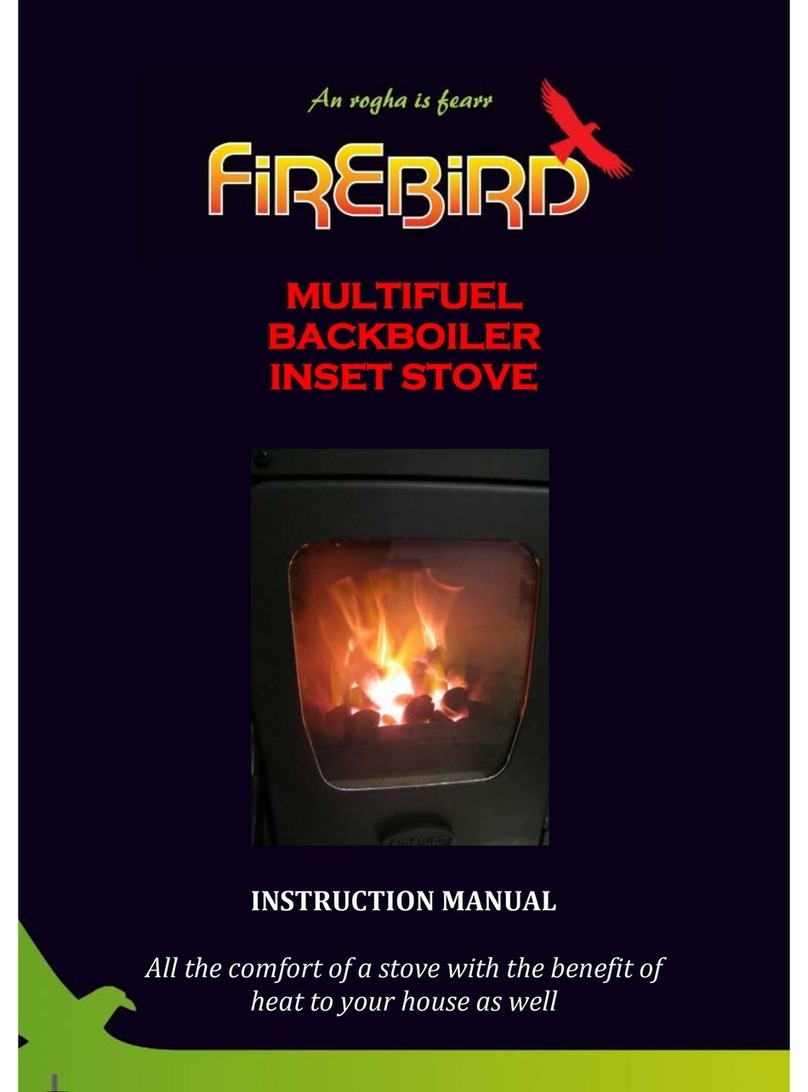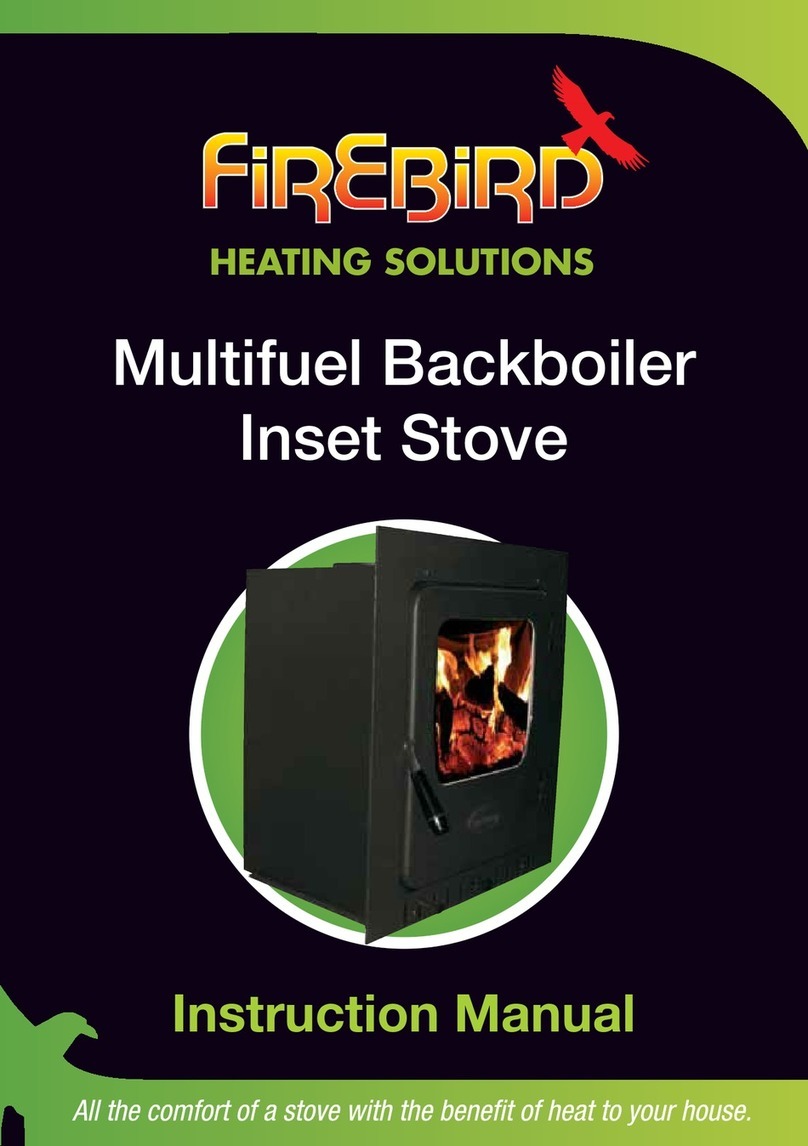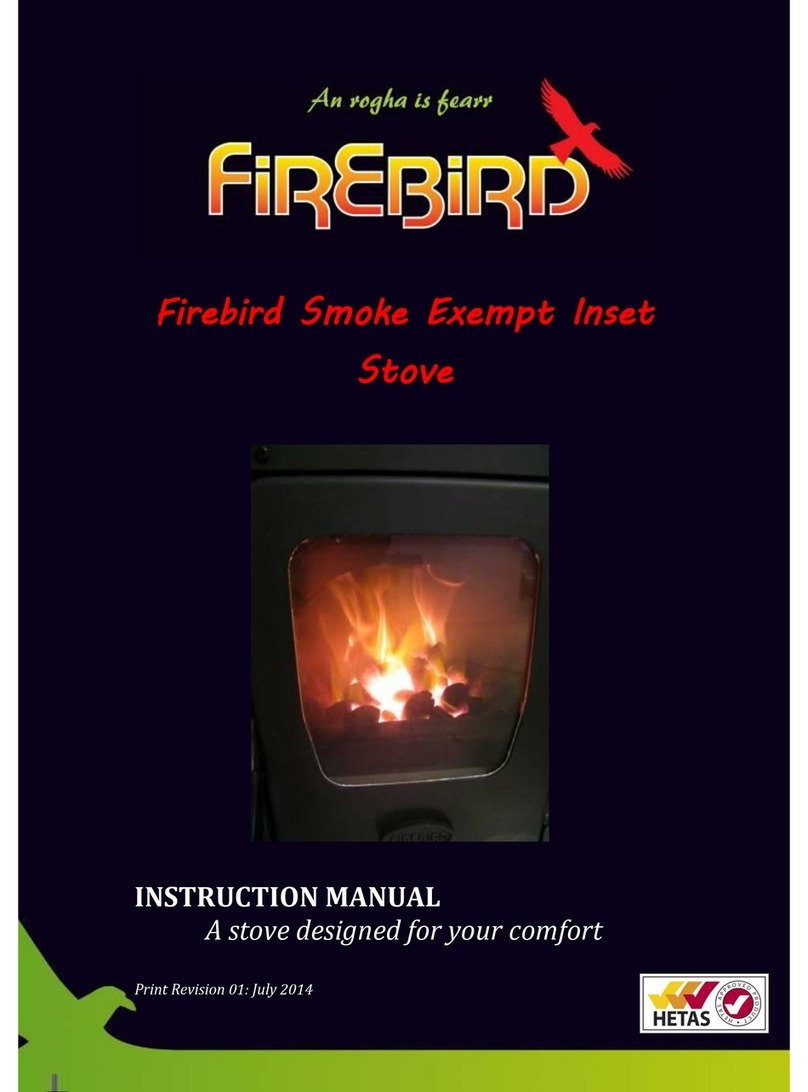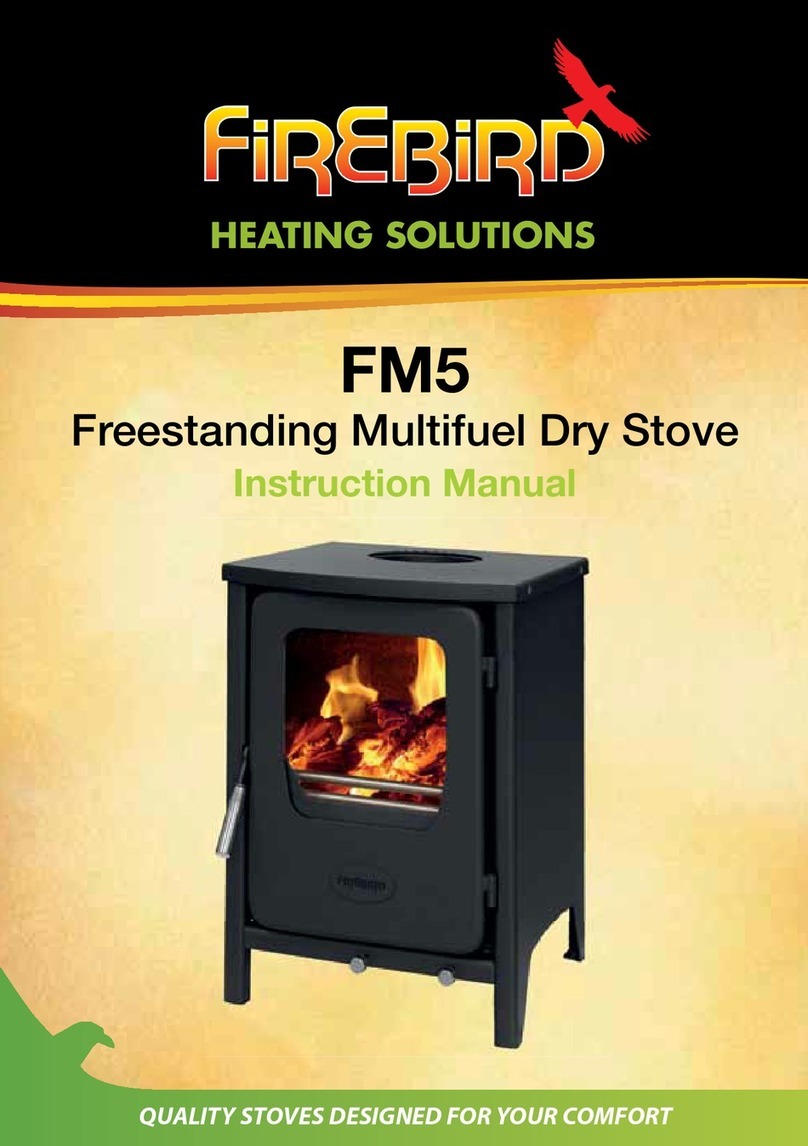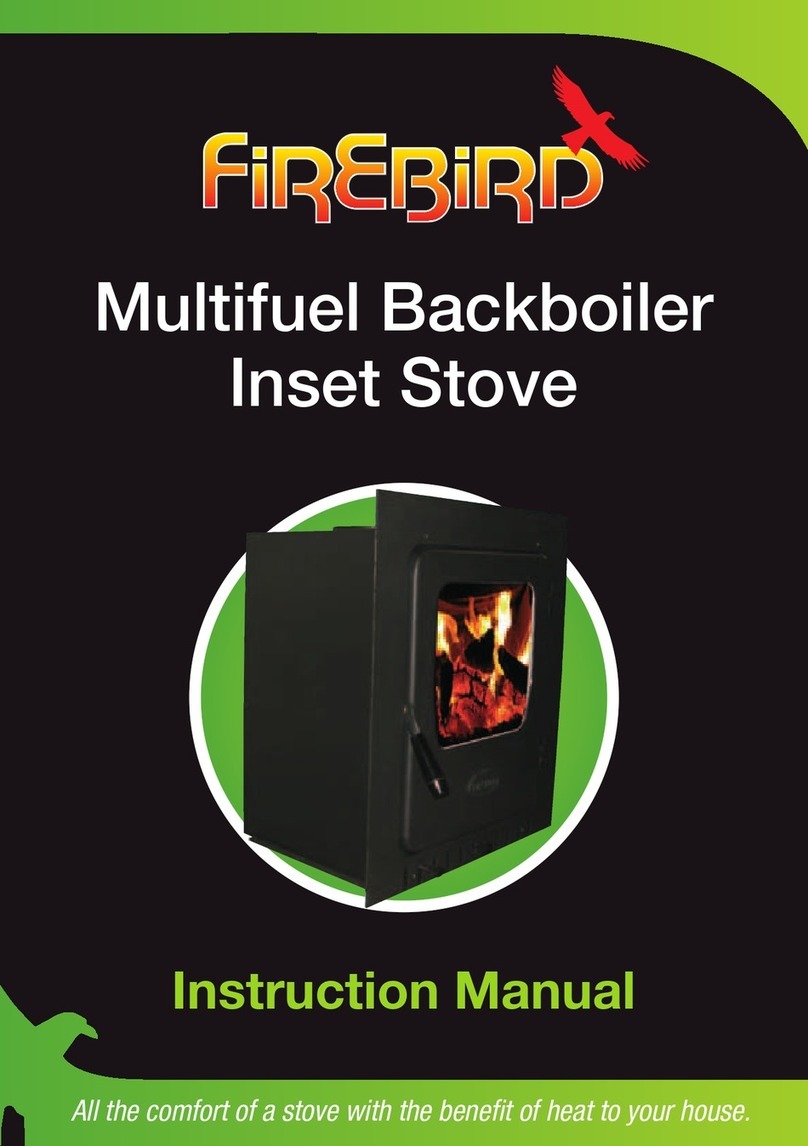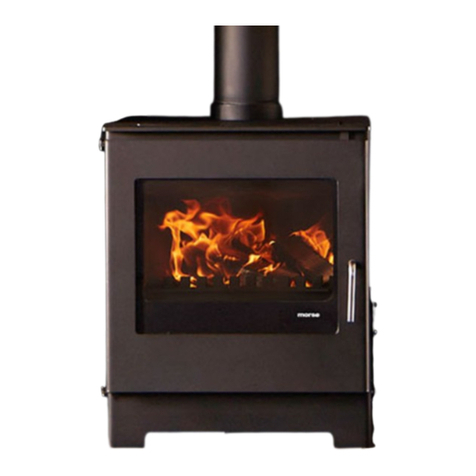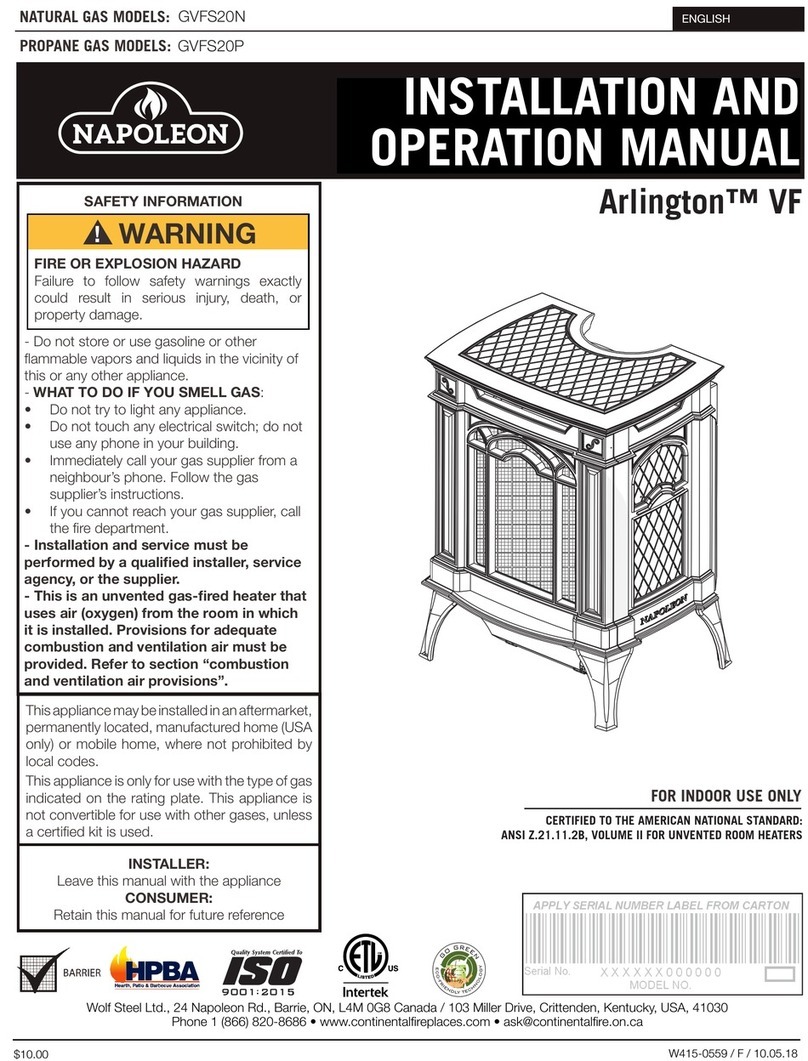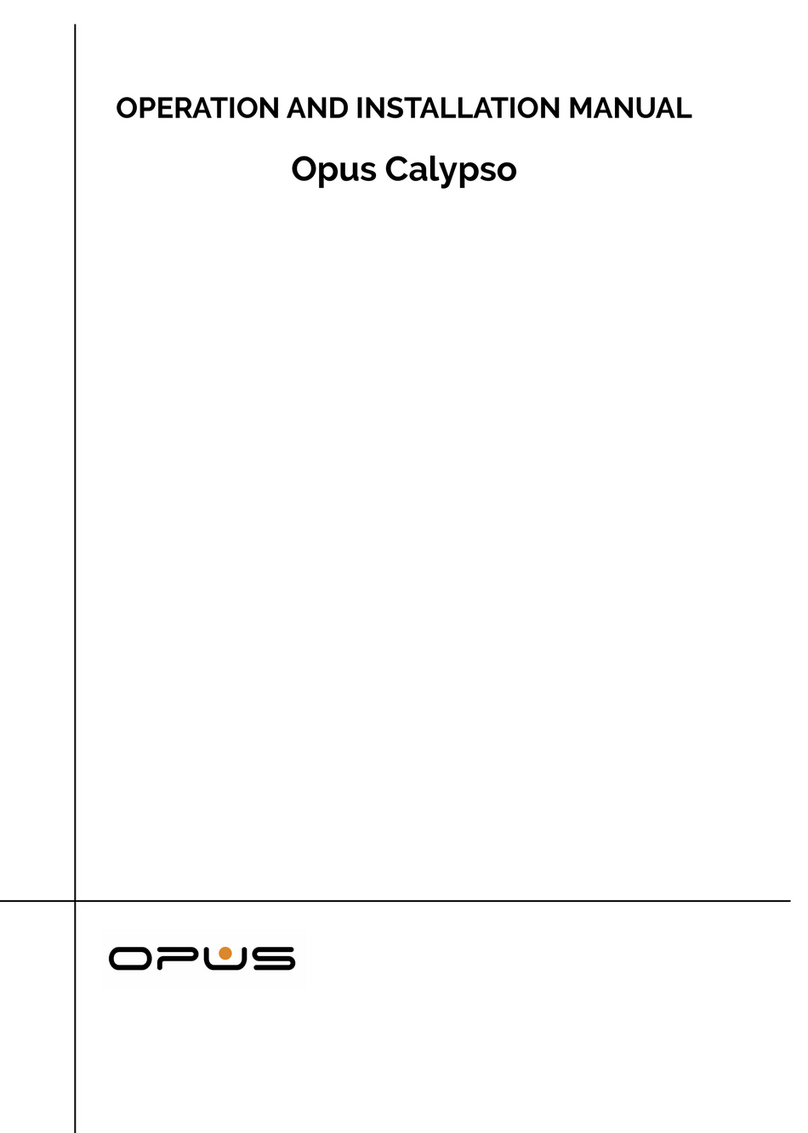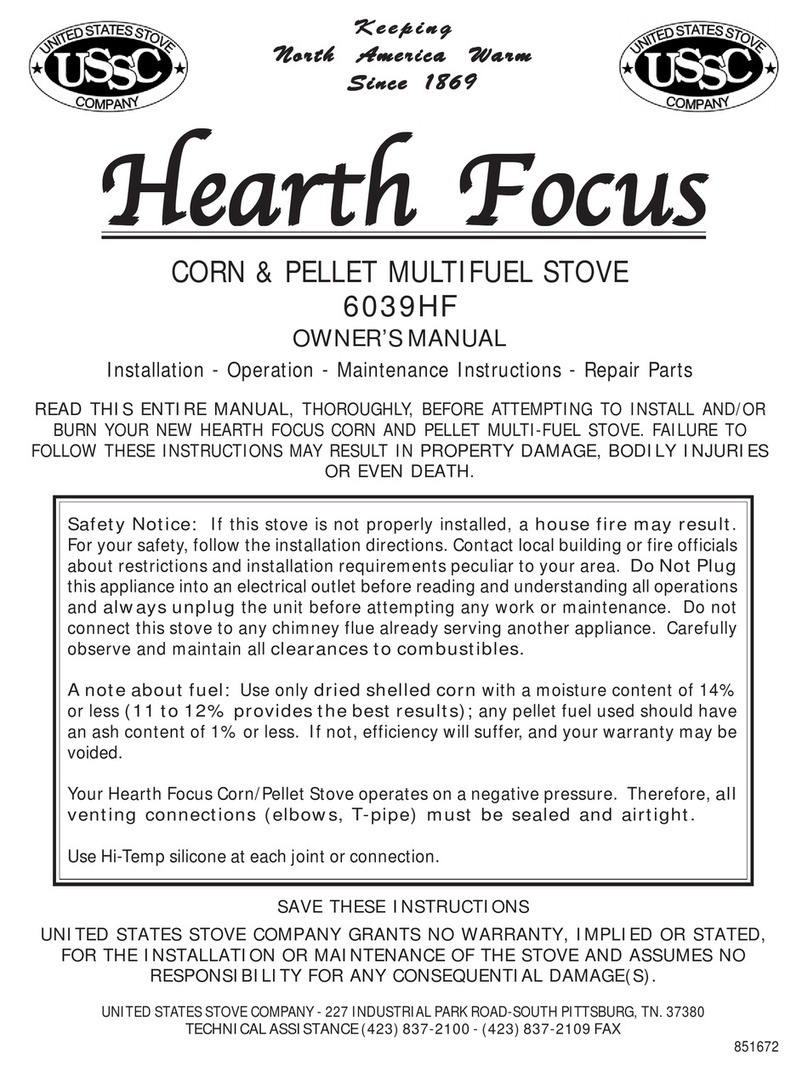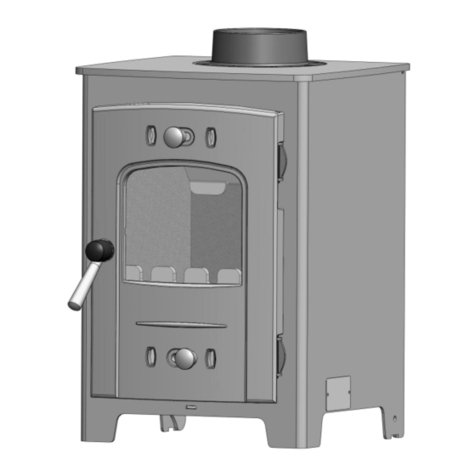FireBird Multifuel Dry Inset Stove Series User manual

A stove designed for your comfort
Instruction Manual
Multifuel Dry Inset Stove
HEATING SOLUTIONS


1
INDEX
Page
1.0 INTRODUCTION ......................................................................................... 2
2.0 IMPORTANT SAFETY NOTES ............................................................... 2
3.0 TERMS & CONDITIONS OF WARRANTY ......................................... 3
4.0 INSTALLATION INSTRUCTIONS
4.1 Performance ..................................................................................... 4
4.2 Health and Safety ........................................................................... 5
4.3 Air Supply .......................................................................................... 5
4.4 Fireplace ............................................................................................. 6
4.5 Hearth ................................................................................................. 6
4.6 Chimney/Flue .................................................................................. 6
4.7 Installing and Back Filling ......................................................... 7
4.8 Checks Before Lighting ................................................................ 8
4.9 Commissioning ............................................................................... 10
5.0 OPERATING INSTRUCTIONS
5.1 Fuels ..................................................................................................... 10
5.2 Lighting and Controlling ............................................................ 11
5.2.1 Wood ...................................................................................... 11
5.2.2 Smokeless Fuel ................................................................... 12
5.3 Overnight Burning ......................................................................... 12
5.4 Clearance of Ash ............................................................................. 12
5.5 Throat Plate (Baffles) .................................................................... 12
5.5.1 Initial Burning ..................................................................... 12
5.5.2 Regular Checking .............................................................. 12
5.6 CO Alarms .......................................................................................... 12
5.7 Extractor Fans ................................................................................... 12
6.0 MAINTENANCE
6.1 Cleaning ............................................................................................. 13
6.2 Door Seals .......................................................................................... 13
6.3 When Not in Use ............................................................................. 13
6.4 Chimney Cleaning ......................................................................... 13
6.5 Chimney Fires ................................................................................... 13
6.6 Fume Emission ................................................................................ 13
6.7 Servicing ............................................................................................ 14
6.8 Spare Parts ......................................................................................... 14
7.0 TROUBLE SHOOTING ............................................................................... 14
8.0 WARRANTY REGISTRATION .............................................................. 15

2
1.0 INTRODUCTION
We would like to thank you for purchasing a high efficiency, Firebird multifuel dry inset stove
(hereinafter referred to as“the inset stove”). The stove is manufactured in its entirety in our
factory in Baile Mhic Íre, Macroom, Co. Cork, using the highest standard of workmanship and
latest technology.
This instruction manual has been produced for the reference and guidance of qualified
installation technicians.
You should ensure that all installation, servicing and commissioning works are carried out
by a HETAS approved or competent, qualified engineer. It should be noted that it is the
responsibility of the installer/householder to ensure that the inset stove is properly
commissioned. Failure to do so may invalidate the warranty.
2.0 IMPORTANT SAFETY NOTES
• Thetermmultifuelreferstocommerciallyavailablesolidfuelssuchaswood,
smokeless coal and anthracite. The appliance shall not be used as an incinerator;
only recommended fuels shall be used. Liquid fuels should never be used when lighting
or filling the fire.
• Donotstoreliquidfuelsinthecloseproximitytotheinsetstove.
• Theinsetstoveisdesignedinsuchaway,thatundernormalburningconditions,the
fumes pass up through the chimney flue and do not escape into the home. Please ensure
that the flue system is checked regularly, that no cracks or openings are evident and that
the seals on the inset stove are in good condition.
• ENSURETHEBAFFLESAREALWAYSINPLACEWHENLIGHTINGTHEINSETSTOVEAND
NEVERLIGHTAFIREIFTHEBAFFLESARENOTINPLACE.
• THEINSETSTOVEDOORSHOULDNOTBEKEPTOPENWHENTHEFIREISLIT/BURNING.
• Theinsetstoveshouldneverbeoverstocked/overlled.Thedraughtsettingsshouldbe
reduced if this occurs.
• Amechanicalairsupplyshouldneverbeaddedtotheinsetstove.
• Theinsetstovereacheshightemperaturesandcanbehottotouch.Ensurethatsafety
guards (in accordance with BS8423:2002) are in place.
• Donotplaceanyfurnitureorcombustiblematerialwithin800mmoftheinsetstove.
• Pleaseensurethatoperatingtoolsareusedwhereprovided.Thestovebecomesveryhot
during operation and should not be touched by bare hands.
• EnsurethatBS8303,codeofpracticeforinstallationofdomesticheatingandcooking
appliances burning solid mineral fuel, is adhered to at all times.
• Aerosolsshouldnotbesprayedneartheappliancewhilealight.
• Ensurethefollowingcodesandstandardsareadheredto:
- BS EN 15287 – 1:2007 design, installation and commissioning of chimneys.
- BS EN 14336:2004 heating systems in buildings.
- BS EN 12828:2003 heating systems in buildings.
- BS EN 12831:2003 heating systems in buildings.
- Method of calculation of the design heat load.
• Pleasereadthismanualcarefullypriortoinstallationoftheinsetstove.
•Alllocalregulations,includingthosereferringtonationalandEuropean
standards, need to be complied with when installing the appliance.

3
3.0 TERMS & CONDITIONS OF WARRANTY
• ThisFirebirdproductisdesignedandmanufacturedtogivemanyyearsoftroublefree
service. We provide a comprehensive warranty of 5 years on the inset stove shell and a
2 year warranty on other parts from date of installation, provided installation has
occurred within 12 months from date of purchase.
Other parts include:
- Ceramic glass for thermal breakage-supply only.
- Refractory materials.
- Rope seals, glass seals and cement seals.
- Grates.
- Paint finish.
• ThewarrantywillonlyapplyiftheinsetstoveisinstalledbyaHETASapprovedor
competent, qualified engineer and is serviced annually thereafter. It is important to
retain a copy of all service records and/or invoices.
• Thiswarrantydoesnotcoverspecial,incidentalorconsequentialdamages,injuryto
persons or property, or any other consequential loss.
• Thewarrantydoesnotcoverinstallationandoperationalrelatedproblemssuchas
draught related issues external to the stove, inadequate venting or ventilation, excessive
offsets, negative air pressure caused by insufficient burning of improper fuel.
• Thewarrantydoesnotcoverimpactdamagetoenamel.
• Pleaseensurethewarrantyregistrationform(atthebackofthismanual)isfully
completed by a HETAS approved or competent, qualified engineer and returned to
Firebird within 28 days of complete installation and commissioning.
• Thefollowingterms,laidoutinthewarrantymustbeadheredto:
(a) All claims under the warranty must be within the above stated time limits.
(b) Warranty implies that the product shall be free from defective parts or workmanship
for a period of warranty cover which begins from the date of installation.
(c) The inset stove must be installed and commissioned by a HETAS approved or
competent, qualified engineer in accordance with a) this instruction manual
b) all relevant standards and codes of practice.
(d) Maintenance should be carried out at the intervals outlined in this manual.
(e) Firebird can accept no liability in respect of any defect arising from incorrect
installation, negligence, fair wear and tear, misuse, alteration or repair by unqualified
persons.
(f) The warranty extends to reasonable labour costs except in the case of a 5 year
warranty period whereby any valid claim made after 3 years will not include labour
costs.
(g) Firebird’s prior authorisation must be obtained before examination or repair of the
inset stove takes place.
(h) Firebird will examine all claims made under the warranty and for any claims deemed
invalid, costs incurred will be borne by the householder.
(i) The inset stove must be used for domestic heating purposes only.
(j) Anydefectivepartremovedunderanyorallofthewarranties,
MUST be returned to Firebird.
THE STATUTORY RIGHTS OF THE HOUSEHOLDER
ARE NOT AFFECTED BY THIS WARRANTY

4.0 INSTALLATION INSTRUCTION
4.1 PERFORMANCE
The following highlights the output and test performance of the inset stove:
Fuel Type Wood Ancit Ancit
Output to Space - kW 5.1 6.9 5.8
Efficiency - % 72.7 74.4 74.2
CO (@13% O2) 0.79 0.24 0.31
Mean Flue Gas Temp ˚C 316 310
3
66
Flue Gas Mass Flow g/s 4.3 5.3 4.0
BS Standard BS EN 13229:2001
Weight - kg 95
Test Type Intermittent Intermittent Continuous
Minimum safe distance from combustible materials: sides 200mm and shelf 300mm.
Fuel Type Wood Ancit Ancit
Output to Space - kW 6.2 8.2 6.8
Efficiency - % 75.1 75.6 76.8
CO (@13% O2) 0.87 0.39 0.19
Mean Flue Gas Temp ˚C 317 339 315
Flue Gas Mass Flow g/s 4.1 5.2 4.7
BS Standard BS EN 13229:2001
Weight - kg 105
Test Type Intermittent Intermittent Continuous
Minimum safe distance from combustible materials: sides 300mm and shelf 200mm.
Heat outputs and efficiencies are based on heat over a one hour period, using Ancit solid
fuel. Outputs are obtained by independent testing to BS Standard EN 13229, burning Ancit
solid fuel.
The appliance is capable of intermittent operation when burning wood logs and
both intermittent and continuous operation when burning smokeless fuel.
Firebird 16” Multifuel Dry Inset Stove
Firebird 18” Multifuel Dry Inset Stove
Ancit = Smokeless Coal
4

5
4.2 HEALTH AND SAFETY
When installing the inset stove, please
ensure that the following Health & Safety
Regulations are met:
• UK-HealthandSafetyatWorkAct
1974.
• IRL-Safety,HealthandWelfareatWork
Act 2005, (Construction Regulations
2006).
Installation, commissioning and/or
servicing should only be carried out by a
HETAS approved or competent, qualified
engineer.
The small amounts of adhesives and
sealants used in the manufacture of this
appliance are cured and do not present
any known hazards when used for their
intended purpose.
NOTE: If your Firebird inset stove is not
installed, operated and maintained
properly a house fire may result!
Additional Material Safety Items:
Handling - Adequate facilities must be
available for loading, unloading and site
handling.
Fire Cement - Some types of fire cement
are caustic and should not be allowed to
come into contact with the skin. In case of
contact, wash immediately with plenty of
water.
Asbestos - This stove contains no asbestos.
If there is a possibility of disturbing any
asbestos in the course of installation, then
please seek specialist guidance and use
appropriate protective equipment.
Metal Parts - When installing or servicing
this stove, care should be taken to avoid
thepossibilityofpersonalinjury.
4.3 AIR SUPPLY
It is essential that you provide an adequate
air supply for safe and efficient operation
of your inset stove. The air supply will
ensure efficient combustion. Failure to do
so could result in smoke filling into the
room or blackening of glass.
Air Requirements
A permanent air entry opening or
openings, with a total free area of at
least 550mm2per kW of rated output
above 5kW, shall be provided.
Air duct terminal
fixed to wall
Flexi pipe
Air duct to be fixed with wall plate
at back of chimney
Air receiving zone
Inset stove

If a flue draught stabiliser is fitted, then the
first 5kW of rated output is 300mm2per kW
and the balance of the rated output is
850mm2per kW.
For newer build properties, the
requirements may need to be higher if
the design permeability of the home is
less than 5m3/h.m2. For more details, see
approved document J of the Building
Regulations.
This appliance is capable of having the air
supply introduced through the base (as per
previous page). The same equation with
respect to total free area must be adhered
to. Please order a room sealed kit from
Firebird to ensure air tightness is achieved
NOTE: Only Firebird’s room sealed kit can
be installed with a Firebird inset stove.
Please refer to kit instructions for full
guidelines.
NOTE: No extractor fan should be fitted in
the same room as the appliance.
4.4 FIREPLACE
When fitting into an existing fireplace,
remove fireback or boiler and clear out any
loose back fill material.
Access to the front of the chimney breast
may be required, via a hole, for fixing the
flue pipe and back filling.
4.5 HEARTH
The appliance must be installed on a
hearth that can take the weight and is of a
non-combustible material.
Ensure that when installing the appliance,
the following regulations are met:
IRL - Building Regulations 1997, Technical
GuidanceDocument5,statesthatthe
hearth must extend in front of the
appliance by 500mm and to the sides by
150mm.
UK-Buildingregulationsforclass1
appliances state that the hearth must
extend in front of the appliance by
300mm and to the sides by 150mm.
4.6 CHIMNEY/FLUE
In order for the appliance to have sufficient
draw to perform satisfactorily, a height of
no less than 4.5 meters, vertically from the
top of the appliance to the top of the
chimney, is required. Alternatively,
chimney design with sufficient draught
can be calculated, in accordance with
EN13384-1.
NOTE: a flue draught requirement of at
least 12 Pa is required.
Fireplace surround
Facia area
Opening
16” inset - min 405
18” inset - min 455
16” inset facia - 495
18” inset facia - 545
16” & 18” facia - 610
16” & 18” inset - min 559
Limiting dimensions of
surround and opening
6

7
The existing chimney must be checked
before installing the appliance. It must be
sound, free from cracks and blockages and
swept. It should not have an excessive
cross sectional area greater than 250mm
x 250mm square or equivalent area.
The chimney and connecting flue pipe
must have a minimum diameter of 150mm
and its dimension should not narrow to
less than the size of the outlet socket of the
stove at any point.
Do not connect the inset stove to a
chimney flue which is connected to
another appliance.
It is essential that you use only stainless
steel pipes for your inset stove and that
all installations are carried out in
accordance with building regulations
and manufacturer’s instructions. Always fit
pipes with the narrow side down, to allow
any creosote to run down the inside of the
pipe. This avoids possible fire risk.
Firebird recommend that a thorough
inspection of the chimney is carried out
prior to installation and on a regular basis
thereafter.
The chimney should be of sound
construction, free from debris, capable of
withstanding extremely high temperatures
and have no evidence of cracks or other
faults.
Best installation practice is to install a flue
lining suitable for solid fuels. A rigid
connection adaptor should be used to
connect the flue liner to the inset stove.
Pipe bends should be kept to a minimum
and there should be no more than two 45˚
bends on any installation.
Flues should not pass through ceilings,
floors or any form of combustible walls
without adequate, approved insulation
having been installed, to protect the
combustible material.
If the stove is filled in place of an open fire,
the chimney should be swept one month
after installation to clear any soot falls
which may have occurred due to the
difference in combustion between the
stove and the open fire.
4.7 INSTALLING AND BACK FILLING
1. Remove the inset stove from its
packaging and inspect for any
damage.
2. Placeadjustablelegstothebottomof
the inset stove if required.
3. Fit the appliance into the opening,
making sure it is central. A good seal
should be made between the flange
and the surround.
4. Remove any excess fire cement from
around the flange.
5. Ensure the stove is fixed to the hearth.
There are 4 preformed holes on the
side frames of the base to facilitate
fixing.
6. Before back filling, check the flue
connections. Ensure that the
materials used for back filling are
non-combustible.
7. Fit the flue connector to the top of the
appliance so that it is central to the
chimney and extends to the point
where the chimney narrows.
Ensure that the flue
manufacturer’s instructions are
adhered to at all times.
8. Back fill the appliance with vermiculite
concrete (the mix 6:1; 6 volumes of
vermiculite to 1 volume Portland
cement mixed thoroughly) add
enough water to activate the
cement.

8
Vermiculite
Flue liner
Flue gatherer
Flue adaptor
Flexible liner
Inset stove
Fixing screws
9. All voids must be filled and the flue
pipe flaunched into the chimney,
so that no soot can collect when
sweeping the chimney.
10. Make good the holes in the front and
side of the chimney breast, ensuring
they are airtight. Remove any material
from inside the appliance and check
the flue pipe is clear.
4.8 CHECKS BEFORE LIGHTING
NOTE: Prior to lighting the inset stove,
allow sufficient time for the back fill to dry
at normal conditions.
The following checks should be carried out
prior to lighting a fire in the inset stove:
1. The fire grate is in place.
2. The flue is clear.
3. Ensure that baffles are in place.
4. Check the door fitting.

375
60
160
130
100
9
Typical installation
Fireplace surround
Inset facia
Inset stove
Fixing screws
X
X
60
60
min 415
for 16" inset min 350 mm
for 18" inset min 400 mm
to open door
Limiting dimensions of hearth

10
4.9 COMMISSIONING
Lightthereandcheckalljointsandseals.
Ensure that fumes and smoke are being
taken up the chimney and no fumes are
entering the room.
Before completing the commissioning, the
householder should be advised as to the
operation of the inset stove.
The instruction manual should remain
with the householder.
CO Alarms:
Building Regulations require that
whenever a new or replacement, fixed
solid fuel or wood/biomass appliance
is installed in a dwelling, a carbon
monoxide alarm must be fitted in the
same room as the appliance. Further
guidance on the installation of the
carbon monoxide alarm is available in
BS EN 50292:2002 and from the alarm
manufacturer’s instructions. Provision
of an alarm must not be considered a
substitute for either installing the
appliance correctly or ensuring regular
servicing and maintenance of the
appliance and chimney system.
5.0 OPERATING
INSTRUCTIONS
5.1 FUELS
HETAS Ltd. approval covers the burning of
the following smokeless fuels in this inset
stove:
• Ancit(smokelesscoal).
• AnthraciteLargeNuts.
• Centurion.
• Cosycoke.
• Maxibrite.
• Phurnacite.
• SunbriteDoubles.
• WelshDrySteamCoal(largenuts).
The above fuels are all suitable for smoke
control areas.
NOTE: Petroleum coke should never be
used on this appliance. If used, it will
invalidate the guarantee.
Wood can be used in this appliance.
The two main factors to be considered
when burning wood, are the moisture
content and the density.
Moisture in wood will have an effect on
theCV(amountofheatperunitvolume),
as any moisture in the wood has to be
boiled away before the wood will burn.
It can also create smoke and tars which
could be corrosive and increase the risk
of a chimney fire.
Well-seasoned logs can have
approximatelytwicetheCVof
unseasoned green logs.
Hard wood logs are denser than soft wood
logs and tend to burn for a longer period
of time.
Air dried wood should be seasoned for at
least 12 months before burning.
Wood that has been contaminated or
treated with varnish, paint or other
coatings and preservatives, should not be
used. Not only does it release noxious
chemicals into the air, but it can also
contribute to the amount of tar and
deposits building up in your chimney.
NOTE: You should never over stock/over
fill your inset stove. This is necessary to
avoid fuel falling out onto the glass door
and also to avoid chimney fires. Best
practice is not to fill above the front
frame of the inset stove.

11
5.2 LIGHTING AND CONTROLLING
5.2.1 WOOD
NOTE: Ensure the baffles are properly
installed prior to lighting the inset stove as
per Figure 1. Carry out all checks as per 4.8.
Place some kindling and a firelighter on
top of the grate, add some dry kindling
and a sufficient bed of fuel to enable a
good fire to take off.
Fully open out the secondary air control
(right hand side) and open the primary air
control (left hand side) to about half way.
See Figure 2.
Light the fire and close the door.
The room should be kept well ventilated
on the first lighting, as there may be an
odour and some smoke may be released.
Thisisjustthepaintreactingtotheheat
and will only last for a short time.
Whenthereiswelllit,adjusttheprimary
and secondary air controls to give you the
required level of flame. See Figure 3. For
best results, wood will generally need more
secondary air than primary air.
The following can be used as a starting
base for settings:
- Coal - primary air set on 3; secondary air
set on 1.
- Wood - primary air set on 1; secondary
air set on 3.
Please note however, that these may differ
with respect to fuel quality and draught.
The householder should ensure that they
become familiar with the settings to find
the optimum solution for their particular
stove.
Refuel the appliance when there is still a
good bed of glowing embers. Place the
required amount of logs on the bed, open
the secondary air control fully and close
the door.
Recommended refuelling volumes are as
follows (to achieve outputs highlighted in
section 4.1):
16”Stove
Wood Logs – 1.68kg/hr
Ancit – 1.17kg/hr
18”Stove
Wood Logs – 1.937kg/hr
Ancit – 1.377kg/hr
Oncethenewfuelhastaken,adjustthe
secondary air control.
Figure 2.
Figure 1.
Figure 3.

5.2.2 SMOKELESS FUEL
The same applies as with wood, but
you will require more primary air than
secondary air with smokeless fuel.
When burning Homefire or Anthracite
smokeless fuel, always have the secondary
air fully open on ignition. Leave it open for
3-5minutesandadjustthereafter.
5.3 OVERNIGHT BURNING
To achieve slow burning/overnight
burning with smokeless coal, close the
secondary air and open the primary air
slightly. Please note that slow burning may
cause the glass to blacken and cause sooty
deposits in the flue way.
Furthermore, these settings are guidelines
and are dependent on the draft and fuel
quality.
5.4 CLEARANCE OF ASH
The ash pan should be emptied on a
regular basis and always before it becomes
too full. See Figure 4. If ash is left to build
up close to the grate, it will cause damage
to it.
The ash pan is best emptied before you
riddle the fire, when the ash is at its
coolest. Check under the ash pan once a
week and clean this area if necessary.
See Figure 5. Ensure the bottom plate
(under the ash pan) is always replaced
after cleaning.
5.5 THROAT PLATE (BAFFLES)
5.5.1 INITIAL BURNING
In the first month after installation, the
baffles should be checked before each
ignition to establish a burning pattern to
fuel type. This is necessary because some
fuels deposit more soot than others. In
addition please refer to 4.6 of this manual
“cleaning of flue one month after
installation”.
5.5.2 REGULAR CHECKING
Remove and clean any fly ash or soot that
has built up. This should be done on a
regular basis, about once a month or more
as deemed necessary.
5.6 CO Alarms
Your installer should have fitted a CO alarm
in the same room as the appliance (see
also section 4.9). If the alarm sounds
unexpectantly, follow the instructions
under item no 6.6 below.
5.7 Extractor Fans
Do not fit an extractor fan in the same
room as this stove. This may cause the
stove to emit fumes into the room.
12
Figure 5.
Figure 4.

13
6.0 MAINTENANCE
6.1 CLEANING
When cleaning the glass, always do so
when the inset stove is cold. Abrasive
cleaners or pads should never be used on
the glass. For stubborn deposits, use a
proprietary stove glass cleaner or ceramic
hob cleaner.
The front of the appliance may be wiped
with a damp, lint free cloth and then dried
with a dry lint free cloth. Again, make sure
the appliance is cold.
6.2 DOOR SEALS
Check that the seals are in good condition
and in the correct place. If they are worn,
they should be replaced.
6.3 WHEN NOT IN USE
In the summer months or anytime that the
inset stove is not being used for a long
period of time, clean out the inside
thoroughly and open the primary air
control slightly.
This will help to prevent condensation,
and hence corrosion.
6.4 CHIMNEY CLEANING
The chimney should be cleaned at least
once a year and this can be done through
the inset stove. Remove the throat plates
(baffles) and fire bars prior to undertaking
a chimney clean.
Where the chimney is believed to have
served an open fire installation, it is
possible that the higher flue gas
temperature from a closed appliance may
loosen deposits that were previously
adhered, with consequent risk of flue
blockage. It is therefore recommended
that the chimney be swept a second time
within a month of regular use after
installation
6.5 CHIMNEY FIRES
If the instructions in this manual are
followed and the chimney is cleaned once
a year, chimney fires should not occur.
Should the chimney go on fire, close both
air intakes and ensure the door is fully
closed. This should be enough to ensure
the chimney fire dies. If the fire continues,
then call the fire brigade. Do not open the
inset stove door at any time during this
period as it may cause re-ignition. Leave
the door closed until the inset stove is cold.
The chimney must be swept and carefully
examined for damage after a chimney fire.
6.6 FUME EMISSION
Properly installed, operated and
maintained, this stove will not emit fumes
into the dwelling. Occasional fumes from
de-ashing and re-fuelling may occur.
However, persistent fume emission is
potentially dangerous and must not be
tolerated. If fume emission does persist,
then the following immediate action
should be taken:
1. Open all windows and doors to
ventilate the room.
2. Let the fire go out.
3. Check for flue or chimney blockages
and clean if required.
4. Do not attempt to relight the fire until
the cause of the fume emission has
been identified and corrected. If
necessary seek expert advice.
5 Do not light the fire until the problem
is rectified.

14
The most common cause of fume emission
is a flue way or chimney blockage. For your
own safety, these must be kept clean at all
times.
6.7 SERVICING
The following is a guideline checklist which
can be used during servicing. Note that
other checks may be required (system
dependant):
- Check flue to ensure it is clear and free
from soot.
- Remove baffles, clean and ensure they
are replaced correctly.
- Check air supply to room or inset stove.
Ensure that it is clean, secure
and free from debris.
- Ensure that all seals are in good
condition.
- Ensure that air wash openings
are clear.
6.8 SPARE PARTS
For spare parts please contact Firebird
directly on the following numbers:
Ireland: +353 (0)26 45253
Northern Ireland: +44 (0)28 30888330
UnitedKingdom:+44(0)1752691177
7.0 TROUBLE SHOOTING
FIRE WILL NOT BURN
Check that:
• Primaryandsecondaryairinletsare
open with no obstructions.
• Chimneyandbaesareclear.
• Correctfuelisbeingused.Notethe
recommendation is to use good quality
coal. The test results of this stove have
been achieved using smokeless coal.
• Airsupplytoroomisadequateandnot
blocked.
FIRE NOT RESPONDING TO AIR
CONTROLS/OVER BURNING
Check that:
• Thedoorisfullyclosed.
• Bothaircontrolstotheapplianceare
fully closed.
• Thedoorsealsareinplaceandingood
condition.
• Thecorrectfuelisbeingused.
REDUCING BLACKENING OF GLASS
This stove is designed with an air wash, the
function of which is to reduce deposits on
the glass. Please note that certain fuel
types can cause blackening of glass.
Check that:
• Theapplianceisnotbeingstarvedof
air.
• Badqualityfuelordampfuelisnot
being used.
• Thebalancebetweenprimaryand
secondary air is correct.
ADVERSE WEATHER CONDITIONS
Draught may be affected during bad/poor
weather conditions. In this case, air
adjustmentsmayberequired.

15
STOVE DETAILS
Firebird Dry Inset Stove
16”Dry inset stove. 18” Dry inset stove. Serial Number: .................................................
Stove and System Check
Stove installed and system tested to manufacturer’s manual and regulations.
Stove linked to heating system in accordance with regulations.
Sufficient air requirements (room air vent) installed (minimum 4”or 100mm).
Chimney/Flue System Chimney/Flue Requirements
Clay pot connection. Chimney cleaned.
Stainless steel relining. Flue system sealed.
Flue diameter ........................................... (minimum flue diameter of 150mm).
Flue Draught
Flue draught test complete. Result of test .................................. (min. 12 Pascal’s draught).
Handover Details
First ignition of stove complete.
Operation and controls confirmed.
Manuals handed to householder.
INSTALLER SIGNATURE ........................................................... DATE ............................................
HEATING SOLUTIONS
HOUSEHOLDER
Name: .........................................................................
Address: ....................................................................
.........................................................................................
.........................................................................................
Tel: ................................................................................
Please complete the following details and return to Firebird
to register your Firebird Multifuel Inset Dry Stove warranty.
INSTALLER
Name: .........................................................................
Address: ....................................................................
.........................................................................................
.........................................................................................
Tel: ................................................................................
CUTALONGDOTTEDLINE CUTALONGDOTTEDLINE
8.0 WARRANTY REGISTRATION

16


Photographs, Illustrations & Specifications. This catalogue was correct at the time of going to print. However, Firebird’s policy is one of continuous development.
The right is reserved to change specifications, colour, and prices of the models and items illustrated and described in this publication at any time. Whilst every care
has been exercised in the production of this catalogue, Firebird cannot accept any liability for errors or omissions. For the latest details always consult Firebird.
MLDYIS001
Republic of Ireland
Firebird Heating Solutions Ltd.,
Údarás Industrial Estate,
Baile Mhic Íre,
Co. Cork,
Ireland.
t: +353 (0)26 45253
f: +353 (0)26 45309
e: info@firebird.ie
www.firebird.ie
United Kingdom
Firebird Heating Solutions Ltd.,
Central Avenue,
Lee Mill Industrial Estate,
Nr. Ivybridge,
Devon, PL21 9PE,
United Kingdom.
t: +44 (0)1752 691177
f: +44 (0)1752 691131
e: sales@firebirduk.co.uk
www.firebirduk.co.uk
Northern Ireland
Firebird Heating Solutions Ltd.,
Shean,
Forkhill,
Newry,
BT35 9SY.
t: +44 (0)28 3088 8330
f: +44 (0)28 3088 9096
e: fi[email protected].uk
www.firebird.ie
Table of contents
Other FireBird Stove manuals
Popular Stove manuals by other brands
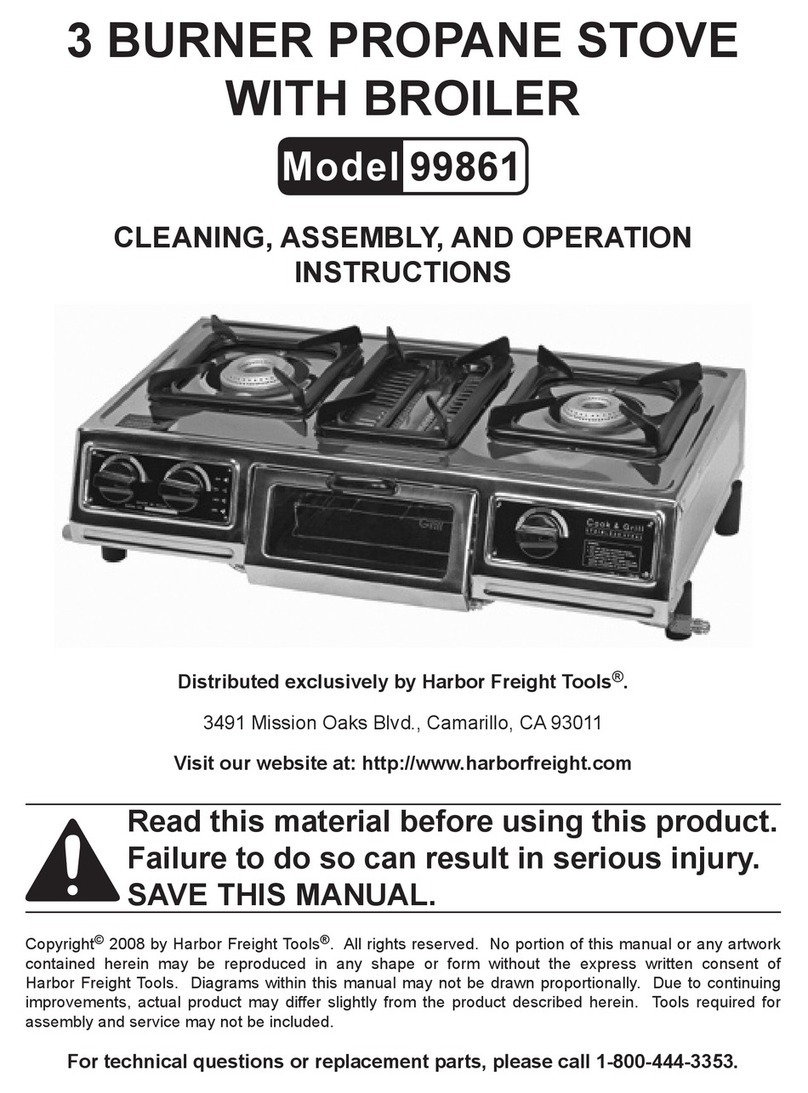
Harbor Freight Tools
Harbor Freight Tools 99861 Cleaning, assembly and operation instructions
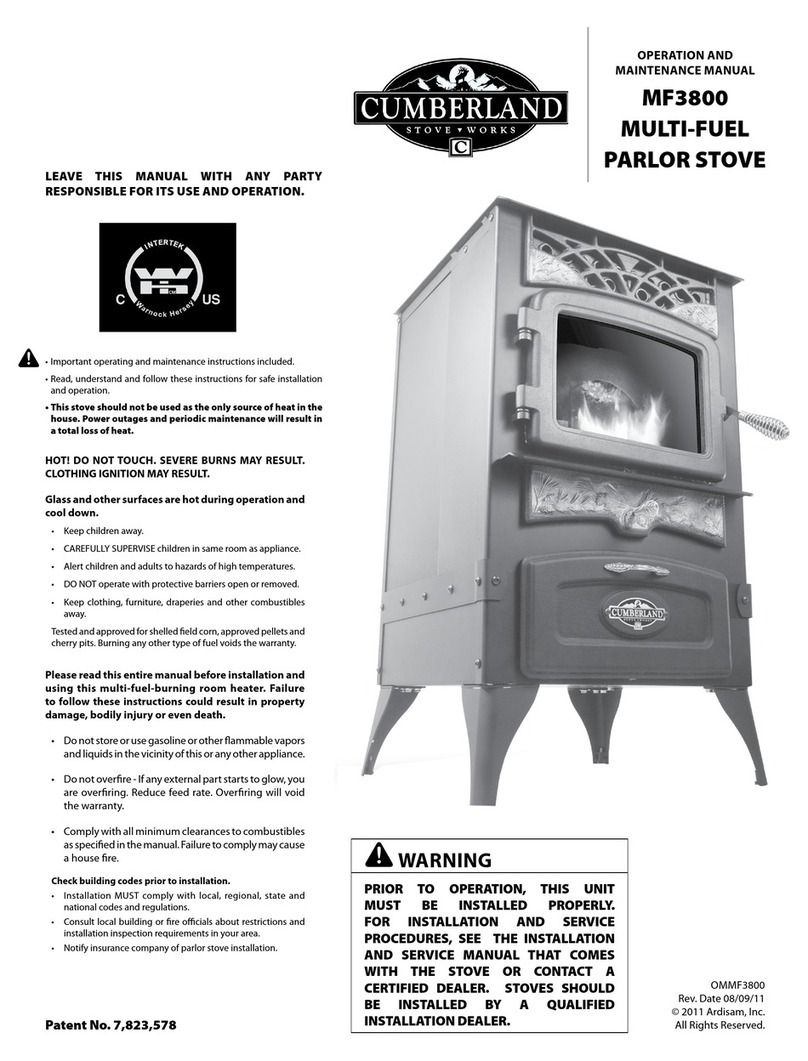
Cumberland
Cumberland MF3800 Operation and maintenance manual
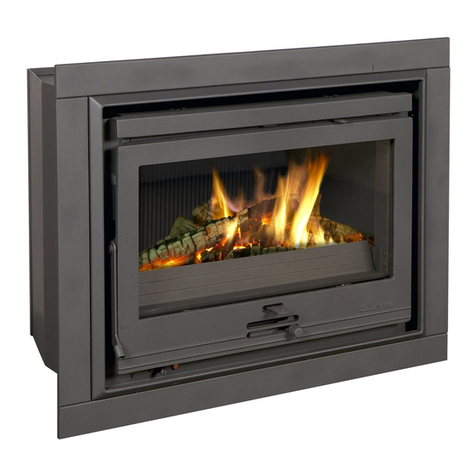
Dovre
Dovre Dovre Fireplace 2020 Installation instructions and operating manual
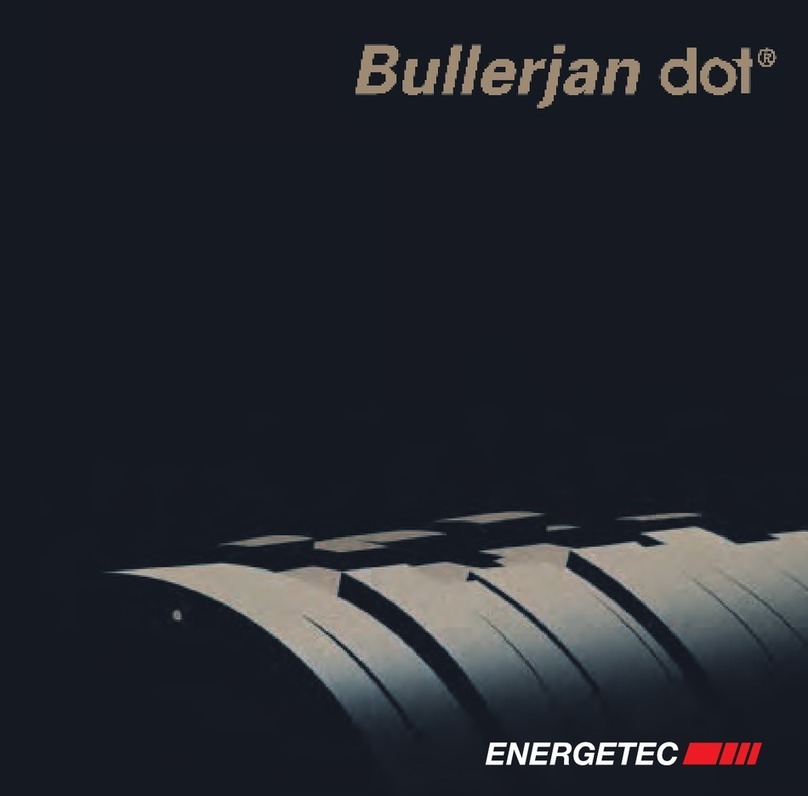
Energetec
Energetec Bullerjan dot manual

Dimplex
Dimplex LEE instruction manual

CASATELLI
CASATELLI CARLO PRO DESCRIPTION / CLEANING / TECHNICAL DATA

Jetmaster
Jetmaster MK6 Installation and operating instructions

Drolet
Drolet CHIC-CHOC Assembly manual

Bronpi
Bronpi MERIDA instruction manual
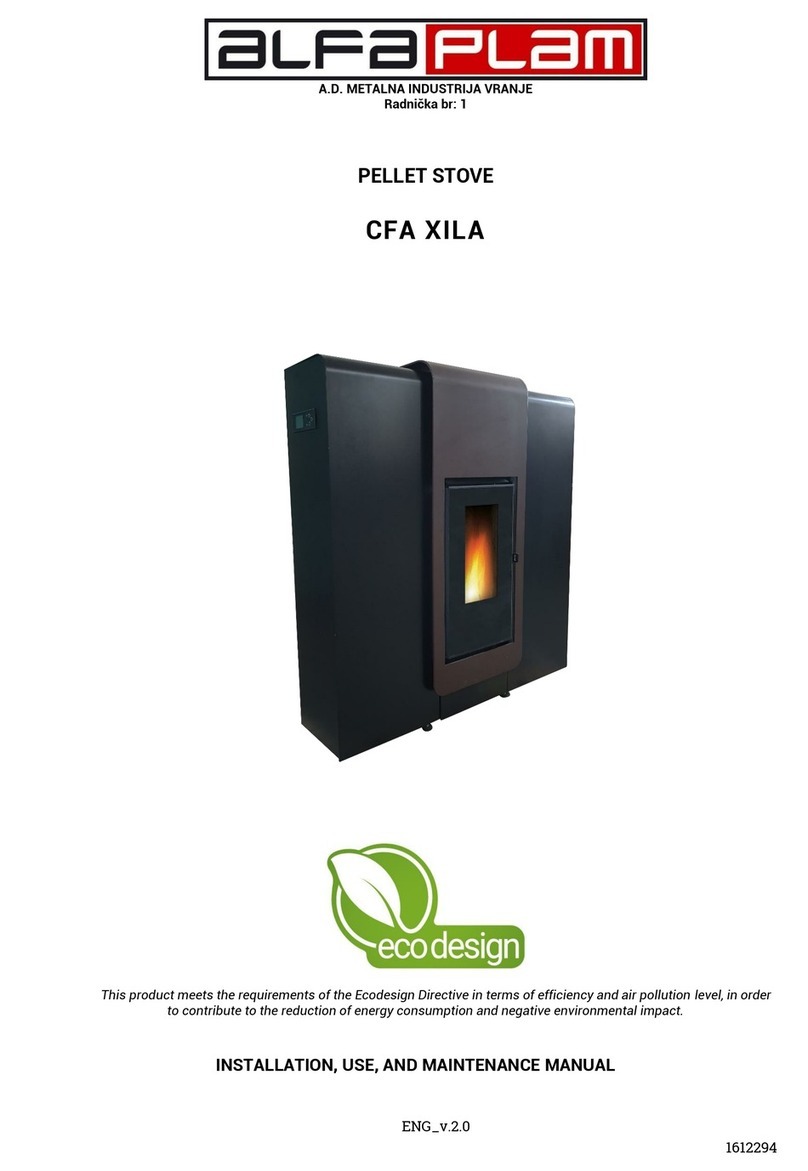
Alfa Plam
Alfa Plam CFA XILA Instructions for installation, use and maintenance manual
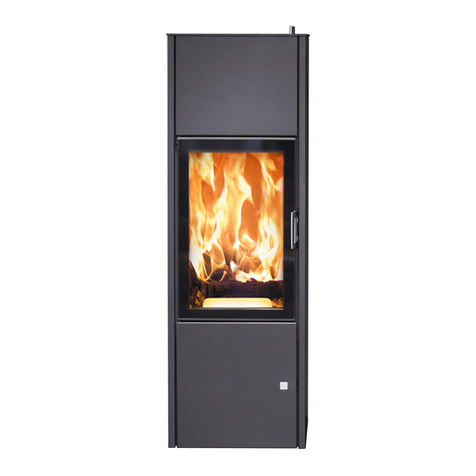
Austro Flamm
Austro Flamm Yan Xtra User instructions
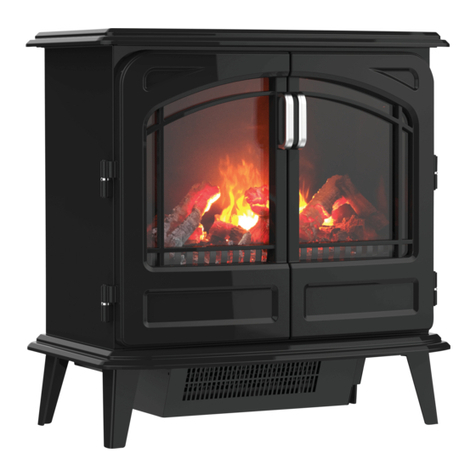
Dimplex
Dimplex Noir RTOPSTV20GN user manual
